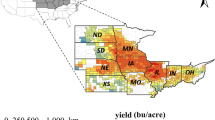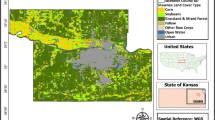Abstract
Yield response factor (K y) is an important basis for implementing efficient irrigation and optimal water allocation. Because K y varies in different sites, understanding its spatial distribution plays an important role in optimization irrigation in Haihe basin. After determining the K y and ET0 of winter wheat, an exponentially increasing function was found between the two parameters. Then, spherical and exponential semivariograms were chosen as proper theoretical models for ET0 and K y, respectively, with R 2 of more than 0.970. By comparing six interpolation methods as well as two procedures, i.e. ‘calculate first, interpolate later’ (CI) and ‘interpolate first, calculate later’ (IC), IC-RK (residual kriging) was considered as an optimal method in interpolating K y. Mapping of K y for winter wheat indicated an increasing trend from the western and northern mountainous region to the eastern plain region in the basin, with the K y of 0.783–1.668 for the dry growing season, 0.760–1.460 for the average growing season and 0.749–1.293 for the wet growing season. Moreover, the K y values were more than 1.0 over the most of this basin, indicating that yield loss was more important than evapotranspiration deficit, and there were greater effect of water stress on the yield of winter wheat.








Similar content being viewed by others
References
Allen RG, Pereira LS, Raes D, Smith M (1998) Crop evapotranspiration. Guidelines for computing crop water requirements. United Nations Food and Agriculture Organization, Irrigation and Drainage Paper 56. Rome, Italy
Cambardella CA, Moorman TB, Novak JM, Parkin TB, Karlen DL, Turco RF, Konopka AE (1994) Field-scale variability of soil properties in central Iowa soils. Soil Sci Soc Am J 58:1501–1511
Cui YL, Li YH, Mao Z (1998) The crop-water production function with the influence of reference evapotranspiration taken into account. J Hydraul Eng 3:48–51
Dağdelen N, Yılmaz E, Sezgin F, Gürbüz T (2006) Water-yield relation and water use efficiency of cotton (Gossypium hirsutum L.) and second crop corn (Zea mays L.) in western Turkey. Agric Water Manage 82(1–2):63–85
Dağdelen N, Başal H, Yılmaz E, Gürbüz T, Akçay S (2009) Different drip irrigation regimes affect cotton yield, water use efficiency, and fiber quality in western Turkey. Agric Water Manage 96(1):111–120
Dehghanisanij H, Nakhjavani MM, Tahiri AZ, Anyoji H (2009) Assessment of wheat and maize water productivities and production function for cropping system decisions in arid and semiarid regions. Irrig Drain 58(1):105–115
Doorenbos J, Kassam AH (1979) Yield response to water. United Nations Food and Agriculture Organization, Irrigation and Drainage Paper 33. Rome, Italy
ESRI (2007) ArcGIS 9.2 desktop help. Available from http://webhelp.esri.com/arcgisdesktop/9.2/index.cfm?TopicName=How_Radial_Basis_Functions_%28RBF%29_work
Garson GD (2009) Testing of assumptions. Available from http://faculty.chass.ncsu.edu/garson/PA765/assumpt.htm
Goovaerts P (1997) Geostatistics for natural resources evaluation. Oxford University Press, New York
Hartkamp AD, Beurs KD, Stein A, White JW (1999) Interpolation techniques for climate variables. NRG-GIS Series 99-01. CIMMYT, Mexico, DF
Kipkorir EC, Raes D, Massawe B (2002) Seasonal water production functions and yield response factors for maize and onion in Perkerra, Kenya. Agric Water Manage 56(3):229–240
Lovelli S, Perniola M, Ferrara A, Tommaso TD (2007) Yield response factor to water (Ky) and water use efficiency of Carthamus tinctorius L. and Solanum melongena L. Agric Water Manage 92(1–2):73–80
Mardikis MG, Kalivas DP, Kollias VJ (2005) Comparison of interpolation methods for the prediction of reference evapotranspiration—an application in Greece. Water Resour Manage 19(3):251–278
Oktem A (2008) Effect of water shortage on yield, and protein and mineral compositions of drip-irrigated sweet corn in sustainable agricultural systems. Agric Water Manage 95(9):1003–1010
Pereira LS, Cordery I, Iacovides I (2002) Coping with water scarcity. UNESCO, IHP-VI, Technical documents in hydrology, No. 58, Paris
Price DT, McKenney DW, Nalder IA, Hutchinson MF, Kesteven JL (2000) A comparison of two statistical methods for spatial interpolation of Canadian monthly mean climate data. Agr For Meteorol 101(2–3):81–94
Rajput GS, Singh J (1986) Water production functions for wheat under different environmental conditions. Agric Water Manage 11:319–332
Schloeder CA, Zimmerman NE, Jacobs MJ (2001) Comparison of methods for interpolating soil properties using limited data. Soil Sci Soc Am J 65(2):470–479
Sezen SM, Yazar A (2006) Wheat yield response to line-source sprinkler irrigation in the arid Southeast Anatolia region of Turkey. Agric Water Manage 81(1–2):59–76
Shrestha N, Geerts S, Raes D, Horemans S, Soentjens S, Maupas F, Clouet P (2010) Yield response of sugar beets to water stress under Western European conditions. Agric Water Manage 97(2):346–350
Tong L, Kang SZ, Zhang L (2007) Temporal and spatial variations of evapotranspiration for spring wheat in the Shiyang river basin in northwest China. Agric Water Manage 87(3):241–250
Yang H, Zehnder A (2001) China’s regional water scarcity and implications for grain supply and trade. Environ Plan A 33(1):79–96
Yazar A, Sezen SM, Sesveren S (2002) LEPA and trickle irrigation of cotton in the Southeast Anatolia Project (GAP) area in Turkey. Agric Water Manage 54(3):189–203
Zhang RD (2004) Applied geostatistics in environmental science. Science Press and Science Press USA Inc., NJ08852, USA
Acknowledgments
We are grateful to the research grants from the National High Technology Research and Development Program of China (2006AA100203), the National Key Basic Research Program of China (2006CB403406) and PCSIRT (IRT0657).
Author information
Authors and Affiliations
Corresponding author
Additional information
Communicated by A. Kassam.
Rights and permissions
About this article
Cite this article
Li, X., Tong, L., Kang, S. et al. Comparison of spatial interpolation methods for yield response factor of winter wheat and its spatial distribution in Haihe basin of north China. Irrig Sci 29, 455–468 (2011). https://doi.org/10.1007/s00271-010-0251-3
Received:
Accepted:
Published:
Issue Date:
DOI: https://doi.org/10.1007/s00271-010-0251-3




